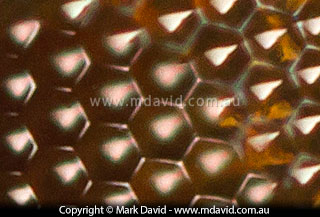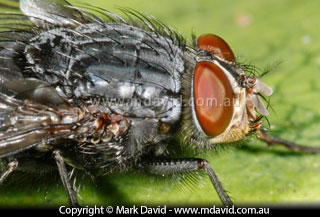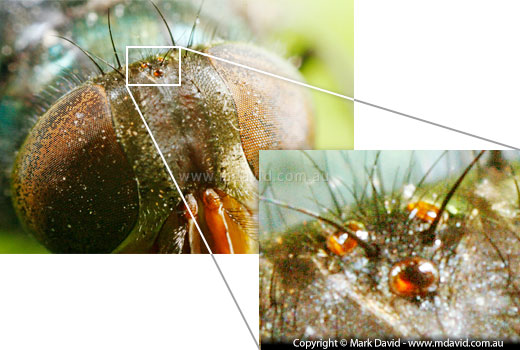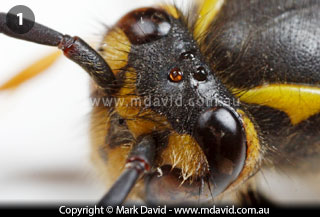Insects come in lots of shapes and sizes, and they have different numbers of eyes too.

This praying mantis has five eyes.
Some insects have five eyes while most don’t have that many. What makes it a
bit complicated is that insects have two types of eyes: compound eyes and simple eyes.
Some have one type, and some have both types of eyes.
Compound eyes
I’ll start by talking about compound eyes because they’re usually the first
ones you notice. If you look at the photo of the dragonfly head below and the enlarged
sections from the photos alongside it, you’ll see that the surface of those big eyes
is covered with lots of facets. Each one of those facets is a lens, and when you cluster
all those lenses together into the one structure you end up with a compound eye.
That dragonfly has two of those compound eyes, and with all of those lenses working
at once it would be able to see in almost every direction without moving its head.

The eyes of a dragonfly. Each of those little dots shown in the close-up
is another lens.

A more extreme magnification shows off the individual lenses more clearly.
And look at the photo of the fly below. The big, red-brown compound eyes, covered in lots of
individual lenses like in the dragonfly, are clearly visible on each side of its head.

The two large compound eyes are clearly visible in this picture
of a fly.
Scientists believe those compound eyes would provide the fly a crisp, detailed view of
the things nearby. However, they also believe that as things get further away from the fly,
they would become less clear. So the idea is that the compound eyes give sharp images of
things up close and a blurred view of stuff in the distance.
Simple eyes
Flies don’t just have those big compound eyes. They also have simple eyes. Simple
eyes don’t have lots of lenses covering their surface like compound eyes. Instead, each
simple eye is a single lens. If you look at the photo below you’ll see a triangular
formation of three orange-brown dots. Those are the simple eyes found on top of the
fly’s head, in between the big
compound eyes.

So that’s a total of five eyes on the fly. Insects can have as many as three
simple eyes. Scientists believe those simple eyes wouldn’t be so good
at seeing detail, but helpful in seeing movement.


1: Five eyes on this European Wasp 2: Only the two compound eyes on the beetle
When you have a look at the picture of the beetle you’ll see that it lacks the
three small simple eyes and only has the two compound eyes.
I started this by saying insects come in lots of shapes and sizes. That kind of diversity
applies to insect sight too. For example, it’s believed that some insects see colours and
some don’t. Some have small eyes, while a dragonfly has huge compound eyes covering
most of its head. Those elaborate compound eyes on the dragonfly would help it fly with a
lot of precision and with lots of speed, seeing other insects and not bumping into things.
So now we know all that stuff, how many eyes do insects have? The answer is: usually two,
but a whole lot of them have as many as five.
How many eyes do spiders have?


Birds

Insects and spiders

Other stuff














